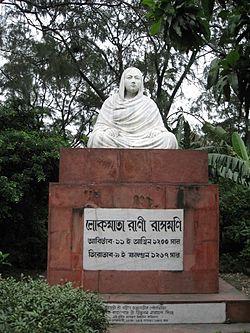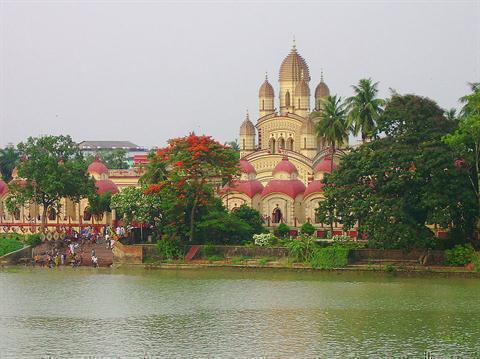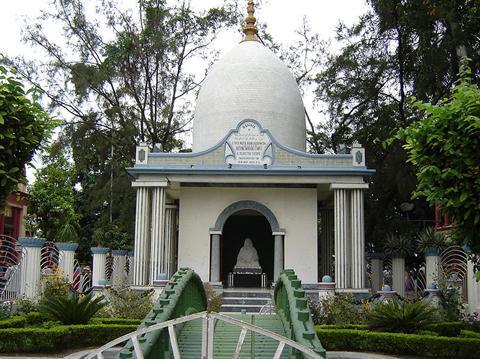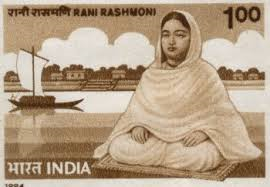RANI RASMANI OR RANI RASHMONI
Contents
. Introduction
. Birth and Early Childhood
. Turning Point
. Family Life
. Death of her husband and other developments
. Crusade against injustice
. Defiance to British Laws
. Construction of Dakshineshwar Temple
. Last days and Death
. Conclusion
Introduction
 In India Lord Shiva’s consort Mother Parvati or Shakti is considered as the dynamic creative mother aspect of the Godhead. She cannot exist without Shiva and Shiva cannot personify without Shakti. She is the one who creates and at the time of dissolution, it is she who destroys or swallows her own creation. According to the Tantras, the Supreme Energy which is the highest personification of God is feminine. Thus she is contemplated as a Goddess under various names like Durga, Devi, Kali, Lakshmi, Uma, Parvati etc.
In India Lord Shiva’s consort Mother Parvati or Shakti is considered as the dynamic creative mother aspect of the Godhead. She cannot exist without Shiva and Shiva cannot personify without Shakti. She is the one who creates and at the time of dissolution, it is she who destroys or swallows her own creation. According to the Tantras, the Supreme Energy which is the highest personification of God is feminine. Thus she is contemplated as a Goddess under various names like Durga, Devi, Kali, Lakshmi, Uma, Parvati etc.
In Ancient India, Hindu religious books like Vedas, Ramayana, Mahabharata and Upanishads have described the equal status enjoyed by women and men and names of several women have been mentioned who were great poets, philosophers and scholars at that time. The wife was regarded as ‘Ardhangini’ meaning ‘half of her husband’. Since all religious ceremonies were performed by the husband along with his wife, an unmarried man was considered to be incomplete. The Medieval period saw a decline in the status of women but the Modern Period again saw betterment in the status of women with many of them rulers and taking up different areas of education, freedom movement and politics. One such woman was Rani Rasmani who was best known for construction of the Dakshineshwar temple and her association with Shri Ramakrishna Paramahamsa and who lived a brave life doing good for the others and gaining the grace of the Divine.
Birth and Early Childhood
 She was born on 24th September 1793 in Kona village near Calcutta into a poor farming family. Her father was Harekrishna Das and they belonged to the untouchable or Shudra caste. Her early years were spent in helping her mother with the household work and carrying food to the fields for her father. Though her father was a farmer he knew how to read and write Bengali so Rasmani received a basic education in the language. Her father often narrated stories from the traditional religious literature. Being the village story teller he had a rare gift and hence played a vital role in spreading mass education. In the evenings he would read from the Ramayana, Mahabharata and the Puranas to the villagers who would gather at his home. Her parents strong leanings towards Vaishnavism and the tales that she heard every evening sowed the seeds of her later religiosity and generosity.
She was born on 24th September 1793 in Kona village near Calcutta into a poor farming family. Her father was Harekrishna Das and they belonged to the untouchable or Shudra caste. Her early years were spent in helping her mother with the household work and carrying food to the fields for her father. Though her father was a farmer he knew how to read and write Bengali so Rasmani received a basic education in the language. Her father often narrated stories from the traditional religious literature. Being the village story teller he had a rare gift and hence played a vital role in spreading mass education. In the evenings he would read from the Ramayana, Mahabharata and the Puranas to the villagers who would gather at his home. Her parents strong leanings towards Vaishnavism and the tales that she heard every evening sowed the seeds of her later religiosity and generosity.
Turning Point
When she was eleven years old, Rajchandra Das of Janbazar, Kolkata, the son of a wealthy zamindar who was 21 years old at that time accidentally saw her while passing the bathing ghats in his boat in the river Ganga. Her beauty impressed him and as his two earlier wives had died, though initially reluctant to marry, his parents were eager to get him married again as was the custom of those days. Though she was much lower in the social ladder than him, the spirit of Renaissance in Bengal at that time and the wish to break away from the traditional marriage with the usual considerations of dowry and social status influenced him and he decided to marry her. She soon settled down to her new life in the city. Inspite of her rural background she adapted to the rich life of the Zamindar family and became the guiding spirit of the family’s Janbazar estate. Under her direction, the estate was at the forefront of social welfare and reform and uniquely synthesised modern thinking and old traditions.
Family Life
Rajchandra Das’s father Pritaram supplied various commodities to the ruling English class and had developed a close relationship with them. He had bought several estates and had become a very rich man. After his death Rajcharan inherited a lot of money and property. But he was very compassionate and humane. Though as long as her husband was alive she rarely came out in public, Rani Rasmani staunchly supported him in all his philanthropic and social reform activities. Both of them supported the movement of abolition of Sati by Raja Ram Mohan Roy defying the disapproval of the conservative Hindu society. Rajcharan Das established many social welfare institutions like the two bathing ghats in Kolkata, a huge old age home in Nimtala ghat in Calcutta, a gruel kitchen for feeding the victims of floods and tanks for drinking water. He established the first bank of Kolkata in 1829, donated huge amounts for education and arranged free education in Hindu college for a number of students, constructed a number of roads in Kolkata including the earlier Babu road which has now been renamed as the Rani Rasmani road. After the 1823 floods Rani Rasmani persuaded her husband to construct the Babu ghat and Babu road. He established a library in Kolkata and also allocated land freely for the construction of a bridge. They built the Janbazar palace later renamed as Rasmani house. They had four daughters whom they brought up traditionally with strong values.
Death of her husband and other developments
At the age of 49 years, her husband passed away and she took charge of the business and the Zamindari though it was not the norm in those days of conservatism for widows to take the forefront. She continued the charities and humanitarian activities initiated by her husband. She improved civic amenities, built roads, markets, tanks and canals for irrigation and sewage. She took the help of one of her sons-in law Mathuranath Bishwas also known as Mathur Babu to assist her. She was highly intelligent and tactful in her dealings and diplomatically solved situations. Once, one of the best friends of her husband who owed her husband some money requested her to appoint him manager of her estate when she became a widow. Reluctant but not wanting to rudely refuse, she asked him to first return the money he borrowed and when he returned it she informed him politely that being a widow, her sons in law being the future heirs wished to take care of it and she could not refuse them. Thus she tactfully got her money back and also got out of the tricky situation. She was also very brave and never lost courage. Once on her way back from pilgrimage her boat was attacked by robbers. Her bodyguards shot at one of them and to avoid bloodshed she stopped the firing. She confronted the robber chief who offered to stop the bloodshed if she paid him money. As she had no cash, she gave them a gold necklace and few silver vessels in lieu of cash and promised to deliver the cash to them the next day in exchange for their safety. The robbers left them safely and she delivered the cash to them the next day as promised. She often said that her Mother Kali would protect her and if she couldn’t, then none else could save her.
Crusade against Injustice
 Kolkata had a number of lakes and rivers like the Ganges and fishing was one of the main occupations. The East India Company suddenly imposed a tax on fishing in the Ganga to increase their revenue. They oppressed those who could not pay them. The fishermen went to Rani Rasmani for help. Knowing it was impossible to resist the British by force, she shrewdly managed to get the lease of five kilometres of the Ganga by paying the required amount. She immediately ordered her men to cordon off the leased area with iron chains and ordered all fishermen to fish in the cordoned area. Stunned at her courage and watching the elated fishermen resume their fishing the citizens were overjoyed and thousands flocked at the bank of the Ganga to applaud her courage and resistance against the British. Since cargo and other ships could not pass freely the British government summoned a notice for her to appear in the Supreme Court and ordered her to remove the barrier. She refused arguing that she had leased it to protect the interests of the fishermen and had no personal motive behind it. The authorities were helpless and lifted all taxes and restrictions and refunded the entire lease amount back to her. No Panidari or water tax exists even today for fishing in the Ganga unlike the neighbouring states of Bihar and some other places where taxes still prevail. A giant sized iron pillar with a piece of chain stands even now as testimony to her courage next to Adi Bhootnath temple near Nimtala Ghat in North Calcutta.
Kolkata had a number of lakes and rivers like the Ganges and fishing was one of the main occupations. The East India Company suddenly imposed a tax on fishing in the Ganga to increase their revenue. They oppressed those who could not pay them. The fishermen went to Rani Rasmani for help. Knowing it was impossible to resist the British by force, she shrewdly managed to get the lease of five kilometres of the Ganga by paying the required amount. She immediately ordered her men to cordon off the leased area with iron chains and ordered all fishermen to fish in the cordoned area. Stunned at her courage and watching the elated fishermen resume their fishing the citizens were overjoyed and thousands flocked at the bank of the Ganga to applaud her courage and resistance against the British. Since cargo and other ships could not pass freely the British government summoned a notice for her to appear in the Supreme Court and ordered her to remove the barrier. She refused arguing that she had leased it to protect the interests of the fishermen and had no personal motive behind it. The authorities were helpless and lifted all taxes and restrictions and refunded the entire lease amount back to her. No Panidari or water tax exists even today for fishing in the Ganga unlike the neighbouring states of Bihar and some other places where taxes still prevail. A giant sized iron pillar with a piece of chain stands even now as testimony to her courage next to Adi Bhootnath temple near Nimtala Ghat in North Calcutta.
Defiance to British Laws
The Chartered Act of Lord Bentick gave the British the right to purchase and use land for cultivation. They forced the farmers to cultivate land for indigo instead of edible crops as Indigo export to Europe was very lucrative for the British and this created a famine like situation in Bengal. The poor farmers were tortured and killed if they refused. When Rani Rasmani heard about this in the area which was owned by her she decided to send lathi wielding guards to fight along with the farmers. They drove away the indigo merchants of that area and this uprising set a precedent for the Great Indigo Revolt of 1859. Finally the British set up the Indigo Commission which released the farmers from the grip of the Indigo merchants.
Once a musical procession during Puja festival taken from the family house to the Ganges was stopped by the British. This angered the Rani so much that she arranged for a bigger procession the next day. She was served with a show cause notice by the authorities but she tore the notice and was fined for non compliance which she readily paid. She then fenced the area of three kms which severely disrupted traffic on all sides. When the government took the case to court she asserted that the area was owned by her family and in fact it was the Government which had violated her rights. She won the suit and the Government returned her fine amount with the assurance that she had the freedom to celebrate the festival without interruption. The people of Kolkata were so impressed that they composed a couplet about her-
“When the Rani’s horses and
carriage roll down the street, they say,
None, even the English Company,
dares to stand in her way.”
Even though Rani Rasmani was against the rule of the British she stuck to her own views and refused to support the Sepoy Mutiny of 1857 as she felt it would increase religious fanaticism worsening the already existing situation.
Rani Rasmani was greatly affected by the plight of widows and child marriages. She began publicly advocating rational practices like minimising the age difference between the husband and wife as she found most of the young girls were married to old men who died soon leaving them widows at a very young age and extended her support to Ishwar Chandra Vidyasagar’s campaign for widow remarriage. She campaigned against polygamy and submitted a draft bill to the East India company, the then law makers.
Construction of the Dakshineshwar Temple
 The construction of the temple at Dakshineshwar stands as a powerful testimony of her revolt against the tyranny of the high caste Brahmins against the lower caste communities. It is said that on the eve of her departure to Benares on a pilgrimage she dreamt that the Divine Mother appeared before her and ordered her to build a temple for her on the banks of the Ganga instead of going on pilgrimage. She purchased 20 acres of land and it took eight years for completion. When the time came for inauguration of the temple, none of the Brahmins agreed to partake Prasad or officiate as priest as she was a Shudra. Undaunted, she wrote letters to many Pandits asking their opinion. Finally on their advice according to the scriptures, she made a gift of it to a spiritual preceptor and set aside income for its maintenance. Ramkumar was made the priest. His younger brother Gadadhar had the most profound spiritual influence on her. After Ramkumar’s death, she made Gadadhar who later became famous as Shri Ramakrishna Paramahamsa, the priest. The greatness of the temple is that it was open to all irrespective of caste, creed and gender.
The construction of the temple at Dakshineshwar stands as a powerful testimony of her revolt against the tyranny of the high caste Brahmins against the lower caste communities. It is said that on the eve of her departure to Benares on a pilgrimage she dreamt that the Divine Mother appeared before her and ordered her to build a temple for her on the banks of the Ganga instead of going on pilgrimage. She purchased 20 acres of land and it took eight years for completion. When the time came for inauguration of the temple, none of the Brahmins agreed to partake Prasad or officiate as priest as she was a Shudra. Undaunted, she wrote letters to many Pandits asking their opinion. Finally on their advice according to the scriptures, she made a gift of it to a spiritual preceptor and set aside income for its maintenance. Ramkumar was made the priest. His younger brother Gadadhar had the most profound spiritual influence on her. After Ramkumar’s death, she made Gadadhar who later became famous as Shri Ramakrishna Paramahamsa, the priest. The greatness of the temple is that it was open to all irrespective of caste, creed and gender.

Last Days and Death
The famous story of Ramakrishna slapping her during his talks to prevent her mind from wandering was the time when she realised that she needed to concentrate on her own spiritual pursuits. Under his spiritual guidance she immersed herself in the temple garden of Dakshineshwar leaving all her affairs to her son in law Mathur Babu. She died at the age of 68 years on February 19th 1861 leaving behind a rich legacy of piety and philanthropy for generations to come
Conclusion
On September 24th 1993 the bicentenary of her birth was observed and a marble statue of Rani Rasmani stands in Curzon Park near the bus terminus at Esplanade in Calcutta. The Government of India also issued a postage stamp in her memory at that time. She was an indefatigable champion of the poor and the cause of women in Bengal in the nineteenth century. Destiny brought her centrestage to the social reform movement in Bengal and she captured many hearts by her intense spiritualism and crusade for the downtrodden. Her voice of sanity in a world driven by oppression, religious fanaticism and injustice was a rare phenomenon. She will always be remembered as a woman with boundless courage who stood up for the rights of exploited people though her role in the life of Shri Ramakrishna Paramahamsa is the one for which she will always be remembered with deep gratitude and reverence.
